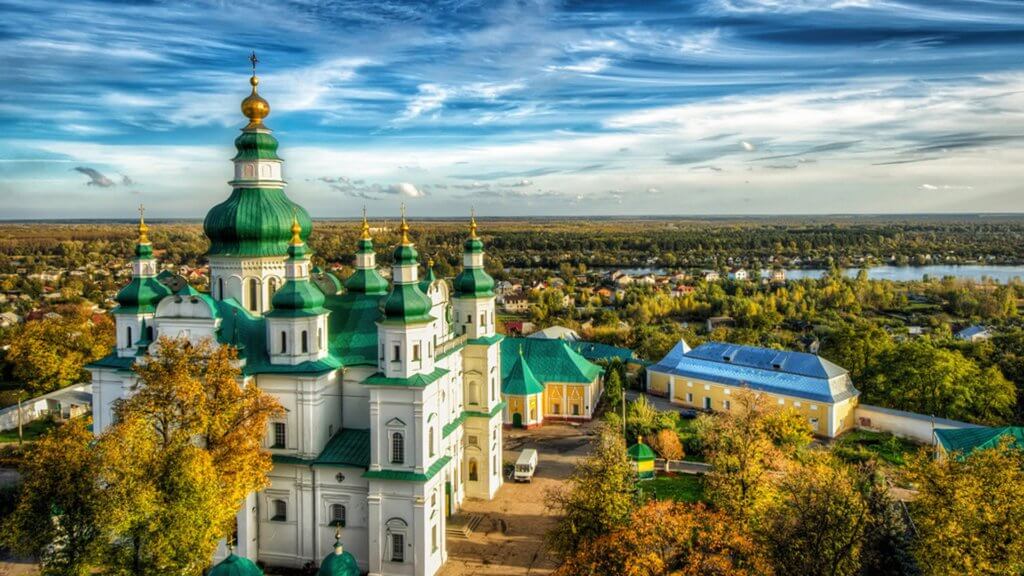Interesting Facts About Ukraine

12 facts about Ukraine
Many people don’t know that much about Ukraine, other than maybe the flag and the fact it’s in Eastern Europe. So here are 12 interesting facts about the country!

1. The largest country in Europe
Ukraine is the largest country in Europe. At 603,628 sq. km., it stretches from Russia in the east to Poland in the west, with the Black Sea running along its southern border. It’s nearly three times the size of the UK and beats the second biggest country, France, by 50,000 sq. km. The state is divided into 24 oblasts (counties).
With such a large area, Ukraine has a lot to offer. From the beautiful Carpathian mountains that offer picturesque landscapes of forests, rivers, and valleys, to beaches found near the city of Odesa and vibrant cultural cities like Kyiv and Lviv. Not only is it an extremely large country, but also a very unique and exciting one.
2. Seven UNESCO World Heritage sites in Ukraine
Ukraine is home to seven sites protected by the UNESCO World Heritage List. These include Kyiv’s Saint-Sophia Cathedral and Lviv’s historic center, Chernivtsi University, as well as unique wooden churches in the Carpathians and the beech forests that surround them.
3. Language The Ukrainian language is the only official language in Ukraine.
Interestingly, the Ukrainian language was rated the 3rd most beautiful language, in 1934, behind French and Persian; it was also rated the 2nd most melodious, behind Italian. In addition, many Ukrainians are bilingual: in many areas, you will find people who speak Russian or those who understand it. The dominant religion is Eastern Orthodox Christianity, which has heavily influenced Ukrainian architecture, literature, and music.
4. TRANSPORT
Ukraine has a well-developed system of public transportation. Every large city and regional center is connected to the railway network and receives passenger trains daily from other major cities. Many cities also contain cheap and efficient bus and tram services, costing as little as 8UAH (0.3$). Airports in Ukraine are easily accessible by public transport and service buses, or taxis which would cost about 7UAH per km. To reach Kyiv Boryspil Airport you can also take an express train from the railway station.
5. The world’s deepest metro station
Arsenalna, along Kyiv’s Sviatoshynsko-Brovarska train line, is the world’s deepest metro station at 105.5 meters below the ground. Staring down from the top of the steep escalator to the darkness of the metro below can be quite scary. However, their construction took place during the cold war era; the threat of nuclear bombs meant such deep-lying stations could protect the citizens of Kyiv from such disaster. Thus, the influence of conflict in the 20th century can be seen, even in such mundane activities as the morning commute to work.
6. Ukrainian Cuisine
The traditional Ukrainian diet includes chicken, pork, beef, eggs, fish, and mushrooms. Ukrainians also tend to eat a lot of potatoes, grains, and fresh and pickled vegetables. The Ukrainian cuisine is extremely varied and exciting, with different ethnic minorities and a rich multicultural history bringing a range of different foods to the table. Nonetheless, popular traditional dishes include varenyky (boiled dumplings with mushrooms, potatoes, sauerkraut, cottage cheese, or cherries) and holubtsi (stuffed cabbage rolls filled with rice, carrots, and meat). The most famous Ukrainian dish is borscht. Whilst many Russians claimed it derived from the motherland, many Ukrainians passionately believe they are the founders of this dish. It consists of soup made from beetroot, cabbage, and potato; true borscht also contains meat, most commonly, pork. Famous Ukrainian drinks are Lviv beer, horilka (vodka) with pepper, medovukha – horilka with honey, Zakarpattya wine, and Lviv coffee. Ukrainians prepare very tasty desserts: cheesecake (syrnyk), poppy cake (makivnyk), honey cake (medivnyk), and many many others. You must try Ukrainian cuisine on your holiday to Ukraine! Explore our gastronomic tours to find something that interests you.
7. CHICKEN KYIV IS NOT FROM KYIV
Contrary to popular belief, the delicious stuffed chicken breast dish is not from Kyiv. In fact, there are several suggestions as to its origins. Whilst some believe that it was created in the Russian Empire, others have suggested that it was created in France and became assimilated into Russian culture under the name, Côtelettes de volaille. It was then renamed Chicken Kyiv by New York restaurants trying to appease their Russian clientele in the 20th century. Neither Chicken France nor Chicken New York, have the same ring to them though…
8. Weather
Ukraine has a mostly temperate, continental climate. Precipitation is disproportionately distributed; it is the highest in the west and north and the lowest in the east and southeast. Winters vary from cool along the Black Sea to cold farther inland. Average annual temperatures range from 5.5 °C–7 °C in the north to 11 °C–13 °C in the south. Summers are not so hot and temperatures range from 17°C to 25(30) °C. However, winters can be very cold, attracting lots of snow and creating a beautiful wintery wonderland, perfect to enjoy an authentic Christmassy getaway!
9. Complex history
Ukraine’s history is both incredibly interesting and complex.
Its unfortunate geography meant that it has changed hands many times throughout the centuries. Arguably, its modern routes can be traced back to the Kyivan Rus, a powerful medieval state that thrived in the middle ages, but was struggling by the 12th century. Monument to the founders of Kyiv The following centuries saw Ukraine change hands between the Mongols, Ottomans, and the Polish-Lithuanian Commonwealth, with Cossack communities attempting to live independently in some areas of Ukraine. During the 18th and 19th centuries, however, Ukraine was divided between the Habsburg Empire and the Russian Empire. By the 20th century, the Habsburg Empire had all but collapsed. In 1918, Ukraine was annexed by the Soviet Union, a status that would characterize their existence throughout the 20th century, as the breadbasket of the USSR. Whilst Ukraine’s struggle throughout history has been extremely tough, cultural influences, from Habsburg architecture to Soviet monuments, give the country a wealth of depth and expression.
10. Chornobyl
Ukraine was at the heart of one of the biggest catastrophes of the 20th century.
Chornobyl Nuclear Powerplant exploded in 1986, leaving a once-thriving community of Ukrainians completely destroyed. The effects of the explosion were felt far and wide, and have recently been dramatized, albeit brutally honestly, in HBO’s recent series of the same name. Recently, it has been possible to return to Chornobyl. Here, you can witness the destruction caused by this disaster, and understand yet another obstacle that Ukraine has managed to overcome as a country. Tours to Chornobyl can be found here.
11. Young Country
Following on from Ukraine’s complex history, it is also one of the youngest countries in the world. It was only in 1991 that the country finally achieved its independence. Such a feat gave many young Ukrainians hope that their country would thrive on its own in the near future. The years succeeding this independence have still been difficult, with Russia continually flexing its muscles. But Ukrainians are proud, patriotic, and, undoubtedly as a result of their history, strong. With accelerating agricultural and IT industries, there is much hope and opportunities for the country barely older than most millennials.
12. FESTIVALS
There are many different festivals and fairs in Ukraine. Ukrainian musicians are flourishing in rock, pop, jazz, folk, electric, drum, and bass. Hence, festivals, such as Dubno-fest and Leopolis Jazz Fest in Lviv are extremely popular. Moreover, Atlas Weekend festival is one of Europe’s biggest festivals, attracting over 500,000 people this year, showing contemporary modern popular music. Meanwhile traditional and ethnic festivals provide insight into conventional Ukrainian celebrations. Many, however, are far from conventional. These include the Malanka festival in Bukovina, the Land Of Dreams Festival in Lviv, the medieval festival of Tustan, the Festival of the Brynza in Rahiv, and the Sorochinsky Fair.
Latest Blogs
-
UK to offer work visas to graduates from world's top universities
-
NEET-UG registrations are up 2.6 lakh this year, crossing18 lakh
-
NEET UG Correction Window 2022 Opens with guidelines by NTA
-
Maximum FMGs to clear screening from Delhi & 3 other states
-
Supreme Court refuses to postpone NEET-PG 2022
-
NEET UG 2022:NTA extends the last date for registration
-
US Universities lead in 28 of 51 subjects ranked by QS Ranking
-
International students in Australia will not be able to change course
-
Toronto university changes name amid controversy
-
Canadian Govt Offers Students Opportunity to Work in Canada
-
JEE Main, NEET 2022: Tie-Breaker Policy| View Details
-
NEET-UG 2022 application process begins
-
Check out salient features of the New Rural Medical Education Bill
-
NEET-UG: Exam on July 17, enrolment from April 2
-
NEET UG 2022 : Confirmation page to be available on DigiLocker
-
Ukraine Medical Students can't be admitted to Indian colleges
-
NEET exam 2022 Not to Have Any Upper Age Limit
-
NRI PG medical fees at deemed universities for converted seat
-
NMC allows FMG students to complete internships in India
-
Maharashtra: MUHS awaits clarity from NMC on Ukraine students

